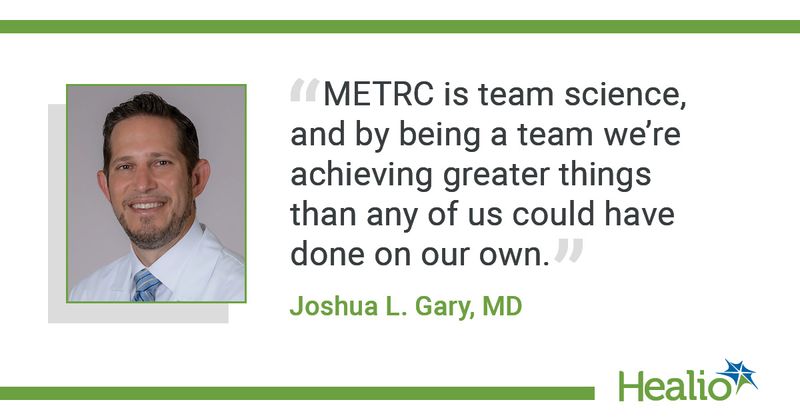Q&A: Consortium strives to identify best practices for severe extremity trauma
Key takeaways:
- The Major Extremity Trauma Research Consortium aims to improve outcomes in severe extremity injuries.
- The consortium has published 61 papers to increase awareness for extremity trauma care.
Military orthopedic surgeons experienced a surge of casualties with complex single or multiple extremity injuries during Operation Iraqi Freedom and Operation Enduring Freedom in Afghanistan.
Surgeons at level-1 trauma centers have experienced similar challenges for treating civilian patients with high-energy traumas. In 2008, the U.S. Department of Defense requested proposals for an inaugural peer-reviewed consortium grant to improve research and evidence for extremity war injury research, according to a press release from the American Academy of Orthopaedic Surgeons. The release noted trauma research teams from the Lower Extremity Assessment Project study, the Southeast Fracture Consortium and the Orthopaedic Trauma Research Consortium developed the Major Extremity Trauma Research Consortium (METRC), which received a grant from the Department of Defense in 2009 “to establish a clinical research platform infrastructure and initiate prospective clinical research targeted to infection, acute compartment syndrome and bone healing.”

Since then, METRC has received additional grants to identify the best practices for the evaluation, treatment and recovery of patients with severe extremity trauma. METRC was awarded the Kappa Delta Elizabeth Winston Lanier Award at the AAOS Annual Meeting in 2023 for conducting 35 studies, enrolling more than 23,000 patients across 82 sites and publishing 61 papers resulting in increased awareness and funding for extremity trauma care.
To learn more about the goals and accomplishments of METRC, Healio spoke with Joshua L. Gary, MD, member of METRC, orthopedic surgeon and chief of the orthopedic trauma service at Keck Medicine of the University of Southern California.
Healio: What are the goals of METRC?
Gary: The initial goals of the consortium were to improve outcomes and decrease complications in patients with severe lower extremity injuries. The collaboration across multiple sites allowed METRC to adequately power large studies that could not be done in individual or a small group of centers. Our consortium has done a lot of work looking into infection rates in the lower extremities and treatments to reduce postoperative infections. We have also been able to obtain functional outcomes of lower extremity injuries to better define the current gaps in knowledge that we need to address with future research.
Healio: What has METRC accomplished to date?
Gary: As a consortium, we recently published the Prevention of Clots in Orthopaedic Trauma (Prevent Clot) study in The New England Journal of Medicine, which is the crown jewel of METRC. It was a prospective, randomized trial of more than 12,000 patients looking at aspirin vs. Lovenox (enoxaparin sodium, Sanofi), an anticoagulant medication, as deep venous thrombosis prophylaxis in hospitalized patients with extremity trauma. The study showed aspirin was not inferior to Lovenox as DVT prophylaxis for death, pulmonary embolism rate or complications. It is one of the largest randomized, prospective studies in the history of orthopedic surgery and was a culmination of many lessons learned with prior work.
Another large trial enrolled almost 1,000 patients to see if vancomycin powder lowered infection rates in wounds around plates for high-energy lower extremity periarticular fractures. That study showed decreased rates of gram-positive infections if antibiotic powder was used over plates before wound closure in the high-energy, at-risk injuries and was published in JAMA Surgery in 2021.
FIXIT was a randomized, prospective surgical trial published in the Journal of Bone and Joint Surgery looking at severe tibia fractures that require plastic surgery coverage. There was a theory that if you used the ring external fixation, it would have lower complication and infection rates than intramedullary nails. Our results showed that the intramedullary nails tended to have lower reoperation and complication rates than the ring external fixators. There are dozens of other publications, and we are now beginning to publish secondary analyses of the large volume of data we have collected across all of these studies. Many of the studies are changing care and informing surgeons how to best manage musculoskeletal trauma and decrease complication rates with level 1 evidence.
Healio: What are the future plans for METRC?
Gary: METRC is continuing to enroll in many studies. We are seeking additional funding and grants to continue to address existing gaps in extremity trauma. While our early research has focused on younger patients with severe trauma similar to our wounded warriors, the burden of trauma in our seniors with osteoporosis and osteopenia continues to grow. We are exploring funding to expand our research to this population. When we initially started, the Department of Defense had wartime interest in injured soldiers and how to get them back to function and life. However, as the conflicts have ended, funding priorities for the U.S. Congress have shifted, and we are adapting to the new environment in seeking additional funding.
Healio: How can surgeons become involved with METRC?
Gary: It is not individual surgeons involved with our consortium. It is orthopedic trauma units in trauma centers, as well. There is an application process for any center if it has the patients who fit the current studies and the resources needed to become involved. METRC is team science and by being a team, we are achieving greater things than any of us could have done on our own.
Reference:
- Kappa Delta Elizabeth Winston Lanier Award presented to Major Extremity Trauma Research Consortium for development of largest orthopedic trauma research endeavor. https://www.prnewswire.com/news-releases/kappa-delta-elizabeth-winston-lanier-award-presented-to-major-extremity-trauma-research-consortium-for-development-of-largest-orthopaedic-trauma-research-endeavor-301743772.html. Published Feb. 10, 2023. Accessed June 20, 2023.
